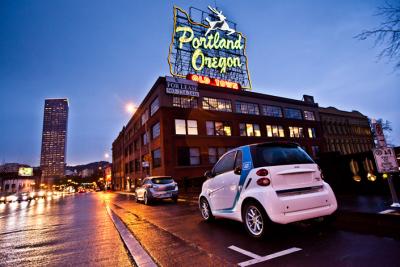The Daimler-owned car-sharing operation Car2Go recently announced that it was massively reducing its coverage area around Portland, Oregon.
According to the company, it’s simply a smart business move, one that will keep cars in areas where they’ll be more likely to be used frequently, and less likely to be ‘stranded.’
DON'T MISS: Portland Car2Go Car-Sharing Fleet To Get Bike Racks
But some local sources note that many of the 18-square-mile portions being cut from the service area coincide with minority and lower-income areas that may be most in need of more options for inexpensive transportation.
The move dramatically cuts the area covered—from 52 square miles to 34 square miles—yet maintains the same number of vehicles currently in the Portland fleet (around 500 vehicles).
“Through extensive market studies, we have found that vehicles remain idle four times longer in low usage areas, affecting the overall availability of vehicles for the Portland membership base,” said Car2Go’s Portland General Manager, Ken Hills, in a release. “By revising our Home Area to focus on areas where our members frequent the most, this will help ensure that our vehicles are in constant circulation, and only occupying fixed space for a limited amount of time.”

Car2Go reduced coverage area - Portland, OR
Putting cars where they’re likely to be used
Car2Go found that 90 percent of members said that vehicle availability was a concern.
Meanwhile 88 percent of the car-sharing service’s membership lived in high-demand areas—where individual vehicles are used up to 21 times per day and 92 percent of trips occur. In low-utilization areas, where only 8 percent of trips occurred, cars are typically parked four times longer.
ALSO SEE: Car Sharing Awareness Grows: 1 In 5 Americans Has Used It Now
In other words, it's smart business to whittle the service area down.
Yet the contraction happens to cut out a number of neighborhoods and communities with higher minority populations and lower household incomes.
The largest section of what’s being cut, a large swath of East Portland (to no surprise, the part of town that hasn't yet been a clever backdrop for Portlandia), is also sorely in need of the basics, like sidewalks, and more difficult to travel within using the current mass-transit network.

car2go - Portland, OR
Is it simply providing stopgap transportation to a more population-dense urban core—which happens to be mostly white, middle-class-to-affluent customers—or does it owe anything to serving poorer, more transportation-challenged, racially diverse areas, which may also be more logistically challenging?
“When we were considering the areas to remove from the Home Area, we solely looked upon member feedback and market studies on how the service was being used,” said Car2Go spokesperson Dacyl Armendariz. “These evaluations are critical to our overall growth strategy and the sustainability of our business.”
MORE: Portlandia Steps Up For Electric-Car Sharing: We're Not Surprised (Aug 2012)
Car2Go, as of earlier this year, was the largest car-sharing operation in the world, with more than 13,000 Smart Forwo models in service, some of which are Fortwo Electric Drive models.
Supply and demand, or greater public good?
As we rely more on innovative solutions to provide patchwork solutions where public-transit backbones fail, regional transportation authorities are increasingly listing car-sharing as part of the transportation pie, and cities are offering sweetheart deals for car-sharing parking in some instances.
What obligation do car-sharing operations have to the communities they serve? Do they serve communities, or is it purely business? As car-sharing becomes the norm, rather than a curiosity, you can bet more cities will be pondering that.
_________________________________________













